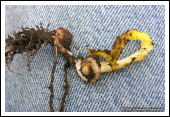Published 15 May 2008
URL: http://www.kingcorn.org/news/articles.08/CornCondition-0515.html
Early Planted Corn Feeling "Under the Weather"
R.L. (Bob) Nielsen
Agronomy Dept., Purdue Univ.
West Lafayette, IN 47907-2054
Email address: rnielsen
at purdue.edu
![]() he
seemingly relentless cool, wet, and cloudy weather of recent weeks has not
only delayed the completion of corn planting, but has also certainly not been
favorable for rapid and vigorous stand establishment for fields of corn already
planted. Germination and emergence have been slow relative to calendar time,
as has subsequent leaf stage development, simply because heat unit accumulation
per day has been less than normal.
he
seemingly relentless cool, wet, and cloudy weather of recent weeks has not
only delayed the completion of corn planting, but has also certainly not been
favorable for rapid and vigorous stand establishment for fields of corn already
planted. Germination and emergence have been slow relative to calendar time,
as has subsequent leaf stage development, simply because heat unit accumulation
per day has been less than normal.
A few fields have experienced chilling injury to kernels during the imbibition
process. Imbibition occurs during the first 24 to 36 hours after planting.
Symptoms of such imbibitional chilling injury include kernels that fail to
germinate or arrested growth of the radicle root or coleoptile.  Instances
of chilling injury during the emergence process have also been reported, often
causing deformed elongation of the mesocotyl (the so-called "corkscrew" symptom)
and either delayed emergence or complete failure of emergence (i.e., leafing
out underground).
Instances
of chilling injury during the emergence process have also been reported, often
causing deformed elongation of the mesocotyl (the so-called "corkscrew" symptom)
and either delayed emergence or complete failure of emergence (i.e., leafing
out underground).
Click on image to open a larger version. To close popup window, click on larger image.
Lower than desired plant populations may justify replanting consideration for some fields, but please base that decision as much as possible on facts and not emotion. Use my worksheet for replant decisions, available on the Web at http://www.agry.purdue.edu/ext/pubs/AY-264-W.pdf.
The appearance of plants in fields where emergence was reasonably successful can be best described as "crappy", primarily due to their yellowish-green color and general lack of vigor. Everyone knows the remedy for poor plant appearance and vigor is simply a return of sunshine and warmer temperatures. If there's good news about such early-season stress, it is that the primary potential effect on yield at this point in time is the effect on "effective" plant population (i.e., plants that will survive to produce a normal-sized ear). Stress that occurs prior to leaf stage V5 has no direct effect on ear size determination simply because the uppermost, harvestable, ear is not initiated until about V5.
If weather conditions over the next few weeks continue to favor sluggish plant development, the risk of further damage to plants from soil-borne disease and insects will increase. Corn plants are very dependent on the energy reserves of the kernel until about leaf stage V3, at which point the plants normally begin transitioning from dependence on kernel reserves to dependence on the nodal root system that develops from the crown of the plant (Nielsen, 2007). Until a plant fully completes this transition (usually by V5 or V6), it is susceptible to stunting or death due to kernel or mesocotyl injury. Consequently, the slower the progress towards V5 or V6, the more at-risk a plant is to continued stressful conditions.
Related References
Nielsen, R.L. (Bob). 2003. Estimating Yield and Dollar Returns From Corn Replanting (AY-264-W). Purdue Univ. Extension. [On-line]. Available at http://www.agry.purdue.edu/ext/pubs/AY-264-W.pdf. [URL accessed 5/15/08].
Nielsen, R.L. (Bob). 2004. Corkscrewed Corn Seedlings. Corny News Network, Purdue Univ. [On-line]. Available at http://www.kingcorn.org/news/articles.04/Corkscrew-0501.html. [URL accessed 5/15/08].
Nielsen, R.L. (Bob). 2007. Root Development in Young Corn. Corny News Network, Purdue Univ. [On-line]. Available at http://www.kingcorn.org/news/timeless/Roots.html. [URL accessed 5/15/08].
Nielsen, R.L. (Bob). 2008. A Recipe for Crappy Stands of Corn. Corny News Network, Purdue Univ. [On-line]. Available at http://www.kingcorn.org/news/articles.08/CrappyRecipe-0422.html. [URL accessed 5/15/08].

